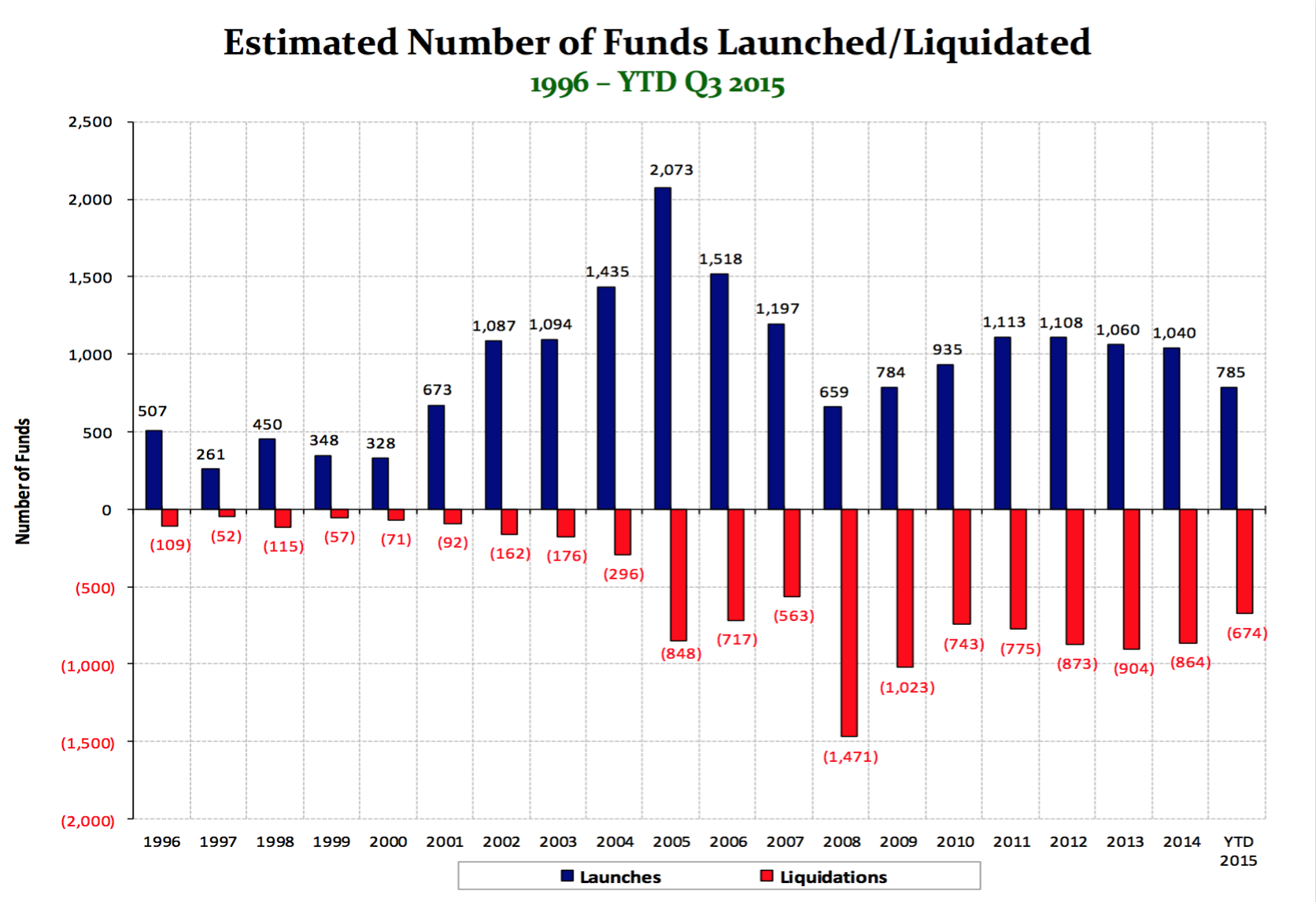“We will be stronger and more flexible under our new business model,” Michael Platt, BlueCrest Capital Management’s founder and CEO, said last December in announcing his $8 billion hedge fund would return investor capital and transition into a family office. “We have delivered industry-leading returns to our investors over the past 15 years but believe that BlueCrest is now better suited to a private investment partnership model.”
The London-based fund blamed its demise on the challenge of fulfilling investors’ many individual needs while earning high returns. Lower fee levels and the cost of talent hurt the fund’s profitability, BlueCrest said. Thus, it closed its doors.
BlueCrest is one of numerous—and some high profile—liquidations in the second half of 2015.
In October, Bain Capital announced the liquidation of its $2.2 billion Absolute Return Capital hedge fund. A week later, Fortress Investment Group shut down its $2.3 billion flagship macro fund.
“This was a difficult decision,” Fortress Principal Michael Novogratz said in a statement. “But we have had an extremely challenging two years, and I do not believe the current environment is conducive to achieving our best results.”
BlackRock shuttered its $2 billion global macro fund (November); Tiger Veda shut down its $167 million fund (December); Seneca Capital Investments said it would return capital from the $500 million hedge fund (December).
Just one week into 2016, the $150 million distressed debt fund Lutetium, along with London-based Nevsky Capital’s $1.5 billion long/short equity fund, declared their unwinding.
Signs an industry shakeout is underway? Not so fast, experts have cautioned.
“This past year was a little more negative than positive for hedge funds,” Peter Laurelli, eVestment’s vice president and head of research, told CIO. “But it’s not the first time the industry has experienced elevated liquidations.”
Capital exiting closing funds will likely flow into new launches, he added, as institutional investors continue to invest in alternatives. These inflows may even offset redemptions.
Hedge Fund Research (HFR) President Ken Heinz also emphasized that there is “cyclicality in the industry as a whole, a normal turnover. Investors are repositioning their allocations to funds that are executing new strategies.”
 Source: Hedge Fund Research
Source: Hedge Fund Research
Estimated annual hedge fund liquidations has remained fairly consistent since the financial crisis, HFR data showed, below 1,000 per year. The high occurred in 2013, with 904 funds closing up shop.
Some 674 funds shuttered in the first three quarters of 2015, compared to 661 during the same period in 2014. The data firm also reported an increase in liquidations in the third quarter of 2015, largely due to falling investor risk tolerance, declining energy commodity and equities markets, and wider performance dispersions among hedge funds.
Most liquidations in 2015, according to Heinz, were not liquidity crises, but “a function of fund underperformance, employee attrition, and initiated by the manager rather than the investor redeeming capital.”
There was also an uptick in the number of hedge fund launches in the third quarter despite turbulent markets, with 269 new funds, HFR’s data revealed. The year-to-date launches totaled 785 in the first three quarters of 2015, a slight decrease from 814 new funds in the same time period in 2014.
“Funds that worked in certain periods may not in others,” Laurelli said. “Newly launched funds will try to take advantage of opportunities created in today’s market conditions, working with a different set of operational circumstances.”
 Source: Hedge Fund Research
Source: Hedge Fund Research
Despite higher levels of liquidations at the close of 2015, things may be looking up for hedge funds in 2016.
eVestment projected continued inflows of $50 billion to $60 billion to hedge funds in the new year, thanks to renewed interest in direct investment from institutional investors.
“If only a fraction of the traditional outflows continues to be directed into the alternatives space, which it is expected to be, and if the hedge fund industry is expected to at least maintain its position within institutional portfolios, which it is expected to do, then the hedge fund industry has the support it needs for another positive year in 2016,” the firm said in a report.
And hedge fund managers are prepared to meet the demand.
Nearly half (44%) of industry firms said they planned to market new funds in 2016, according to research by PricewaterhouseCoopers and the Alternative Investment Management Association (AIMA). A third of US and half of UK liquid alternative managers said the same. More than 60% of surveyed managers reported growing asset bases.
“This industry, having begun the process of institutionalization prior to the global financial crisis, is now maturing rapidly in order to manage a variety of distribution opportunities,” said Jack Inglis, AIMA CEO.
eVestment’s Laurelli also suggested that inflows and outflows next month could sharpen the picture of what to expect for the rest of the year.
“If it’s going to be a terrible year, we’ll know by the end of February,” he concluded. “We’re expecting to see redemptions outpace inflows, and an overhang in January. If there is no clear rebound by February, then it could mean a subpar year for the industry.”
Related: Hedge Fund Flows Collapse in 2015; Aon Hewitt: Why Investors Should Keep Hedge Funds; Hedge Fund Product Wave Set for 2016
